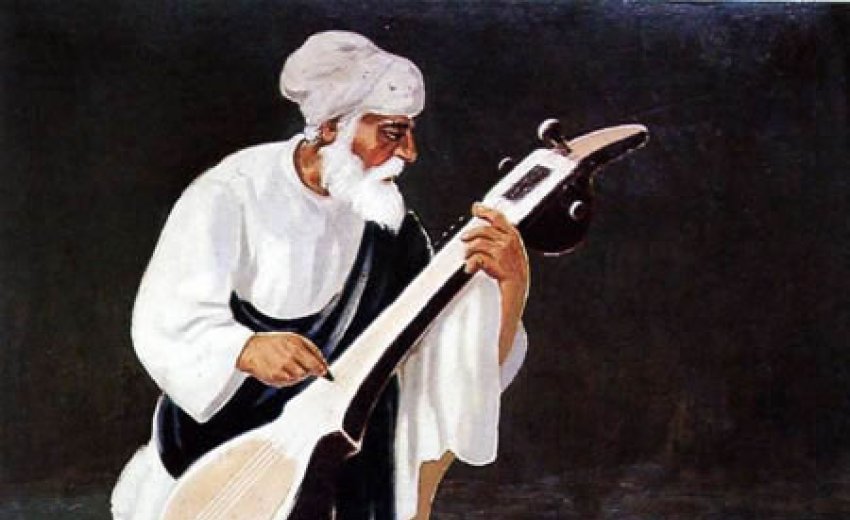Gurmat sangīt (translated as music as per the Guru’s wisdom) – the genre of Sikh kīrtan which most explicitly aims to follow the musical designations in the scripture, as well as the use of traditional accompanying instruments. This genre has undergone a significant revival over the last century, energized not least by a growing global diaspora seeking to deepen its connection with its beloved and revered scripture.
A unique feature of Guru Granth Sahib as a scripture is that it is a hymnal, in that it a compendium of sacred songs, and does not contain any prose. Thus, the entire scripture and its philosophy can be, and was, transmitted musically via song and chant.
Rhymes aid memory and musicality enhances emotional connection. These features make it easy to disseminate the scripture widely. Another noteworthy feature of Guru Granth Sahib is that unlike hymnals of other sacred traditions, it does not contain any musical notation, giving a flexibility in the musical rendering of the songs. It does however contain many musical designations in the song-headings, and guidelines in the song-texts, that have over time been used to different extents and with varying interpretations by musicians singing the sacred songs.
Thus, the sacred songs are sung in a rich variety of musical genres and styles, and this is consonant with the valorization of diversity in the scripture. It is also important to note that Sikh musical practices combine the information contained in the scripture with the knowledge of practitioners that has been transmitted orally and aurally through generations.
Shabad (lit. word) refers to the songs canonized by the Sikh Gurus in Guru Granth Sahib. These songs are mostly those of the Sikh Gurus but also include those of several saint-poets from other religions and spiritual traditions.
It is important to underscore that in the Sikh musical tradition, it is shabad that is held sacred and inviolable. Musical features themselves are not. The musical designations in Guru Granth Sahib are (with very few exceptions) not in the form of instructions, or even recommendations. They are rather indications of the musical practices of the Gurus. What is recommended within the shabad lyrics, and many times over, is devotional singing – kīrtan, and the musical aesthetic deemed best for devotion.
The major organizing principle for the shabad in Guru Granth Sahib is rāg, the melodic modes of the Indian classical music system. Thus, rāg is the most important aspect of the gurmat sangīt genre of Sikh kīrtan, the other is tāl, the rhythmic and metric system of Indian classical music. Gurmat sangīt is therefore also known as the classical genre of kīrtan.
Singing a song in a particular rāg entails following the rāg’s defined melodic parameters. These parameters specify the allowed set of pitches and their ascending and descending patterns, pitch hierarchies and itineraries, and characteristic phrases. This contained and therefore intensified use of pitch patterns results in certain intensified feelings in the musicians and listeners. Rāgs are thus associated with certain moods or aesthetic flavors called ras or rasa.
It can therefore be said that singing a shabad in a particular rāg brings the flavors of that rāg to the sentiments expressed in the lyrics. And singing a shabad in the rāg indicated in its heading in Guru Granth Sahib will aid in bringing the overall effect of the shabad closer to that experienced and expressed by the Gurus themselves. Such an experience would deepen the connection of the devotee with the scripture, the ten human Gurus, and through this spiritual energy, to the divine itself.
In such a musical scheme, sacred lyrics and musical features would come together for an enhanced sacred experience for the devotee. This is the aim of the gurmat sangīt genre. In addition to rāg (and other musical), designations in the shabad headings, the shabad lyrics themselves contain guidelines that recommend and emphasize the aesthetic experience appropriate for connection with the divine.
This aesthetic is one of shabad -attuned consciousness (shabad surat), and serene contemplation (sahaj dhyān); it is marked by peace (shānt), and spiritual bliss (ānand). Immersed in such an aesthetic it is said, devotees can find Har ras (divine ras), the experience of the divine.
Given that gurmat sangīt is based on the Indian classical musical system of rāg and tāl (rhythmic system), a question that often arises is how it is distinct from Indian classical music – Hindustāni and Karnātak sangīt (from the north and south of India respectively?)
Several factors contribute to the distinction between them, and stem from the very difference in their purpose. Gurmat sangīt is devotional music whereas Hindustani and Karnatak sangīt are art music. The primary performance context of gurmat sangīt is the sacred context of the house of worship with the express intent of connection with the divine. In contrast, the primary performance context of Indian art music is the concert stage, with the express intent of performing a rāg (and/or a tāl), and this may or may not be a spiritual experience for the musician or the listener.
This difference has important implications for the aesthetic experience evoked in these musical traditions. Whereas the art music traditions draw on a variety of rasa - the erotic (shringār), pathetic (karun), heroic (vir), wondrous (adbhuta) and peaceful (shānta), the overarching aesthetic aim in gurmat sangīt is the ras of peace.
While individual shabads and their renditions may invoke emotions such as love, longing, courage, and enthusiasm, these are meant to be transitory states to har ras.
Related to this is the relative role and significance of sung text in these musical traditions. The aim of gurmat sangīt performance is to present a shabad using the musical systems of rāg and tāl efficaciously to enhance the mood of the shabad. The entire shabad must be presented, and the sacred lyrics clearly enunciated. The aim of an art music performance on the other hand is to present a rāg and or tāl and demonstrate the skill of the artist.
Developed in secular royal courts, musical artistry is the focal point. In Hindustani sangīt in particular, the relative time spent on sung text is very small compared to the time and attention given to melodic and rhythmic elaboration. In the khyāl genre in particular, the song text can be freely modified and truncated to suit the musical aspects. The performance structure of a song is therefore distinct between gurmat sangīt and the art music idioms.
The traditional gurmat sangīt performance begins with an instrumental prelude in the chosen rāg, known as the shān (lit. glory) in which all the participating instruments pay homage to the divine. This is followed by a sung invocation, manglācharan, in the same rāg, after which the selected shabad is sung in its entirety, with musical elaborations of the text to deepen its meaning.
~ Sat Naam

